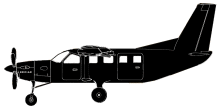
ASN Wikibase Occurrence # 279933
This information is added by users of ASN. Neither ASN nor the Flight Safety Foundation are responsible for the completeness or correctness of this information.
If you feel this information is incomplete or incorrect, you can submit corrected information.
| Date: | Sunday 1 May 2022 |
| Time: | 16:20 |
| Type: |  Quest Kodiak 100 |
| Owner/operator: | |
| Registration: | VH-ICZ |
| MSN: | 100-0188 |
| Fatalities: | Fatalities: 0 / Occupants: |
| Aircraft damage: | Substantial |
| Category: | Accident |
| Location: | 65 km west of Camden Airport, NSW -
 Australia Australia
|
| Phase: | En route |
| Nature: | Private |
| Departure airport: | Orange Airport, NSW |
| Mittagong, NSW | |
| Investigating agency: | ATSB |
| Confidence Rating: |
The pilot of a Quest Kodiak 100 departed Orange Airport, on a private flight, to Mittagong, New South Wales.
At 16:20, while cruising at 9,500 ft, the pilot observed the ‘reservoir fuel’ warning light illuminate. They immediately put the fuel pump on, checked both fuel cocks were on, checked the fuel quantity and balance and reduced the power to preserve fuel. Shortly after, the pilot then received a fuel starvation imminent warning followed by low fuel pressure warnings.
At the time of the warnings, the aircraft was overflying a remote sandstone escarpment region that contained deep gorges and large cliff lines, and was approximately 30 NM (56 km) away from any open land. Due to limited options to conduct a precautionary landing, the pilot continued to cycle the fuel pump, further reduced the power and turned towards an area suitable for a forced landing. During this time, the pilot heard multiple loud bangs.
The pilot continued to cycle the fuel pump and after a few minutes the fuel messages stopped. When the pilot was satisfied that the engine had enough fuel, they tracked direct to Mittagong and landed the aircraft safely at about 16:51.
Engineering inspection
Following the incident, the pilot conducted a post-flight inspection and observed the upper skin on the right wing had crumpled and collapsed. To relieve the vacuum in the wing, the pilot attempted to open the fuel cap by forcing a piece of laminate under the cap. After partly opening the cap, a large amount of air was sucked into the tank and the upper skin of the wing popped back out once the pressure was relieved. However, there was still a large depression of about 11 mm .
An engineering inspection of the right wing revealed the ribs and stringers had failed and the wing was no longer airworthy. Further inspection of the fuel tank vent line inlet recess also revealed mud wasp nests deep inside the vent lines for both wings, which were unable to be inspected or seen visually during the pre-flight inspection.
Sources:
https://www.atsb.gov.au/publications/occurrence-briefs/2022/aviation/ab-2022-002/
Airplane Picture from FlightAware
Images:

When looking at the picture of the airplane , the deduction is clear about the registration : it is VH-ICZ A pictue of this airlane is visible on FlightAware;
Revision history:
| Date/time | Contributor | Updates |
|---|---|---|
| 02-Jul-2022 09:13 | harro | Added |
| 15-Jul-2022 19:57 | Dédé | Updated [Registration, Cn, Source, Photo] |
| 15-Jul-2022 19:57 | harro | Updated [Cn] |
Corrections or additions? ... Edit this accident description
The Aviation Safety Network is an exclusive service provided by:


 ©2024 Flight Safety Foundation
©2024 Flight Safety Foundation